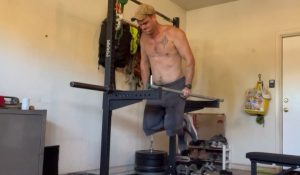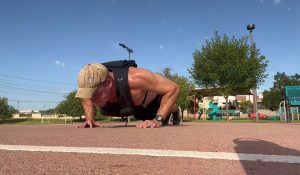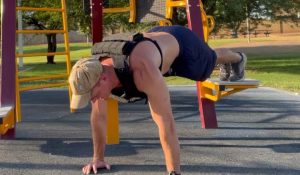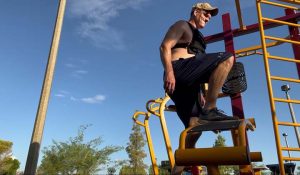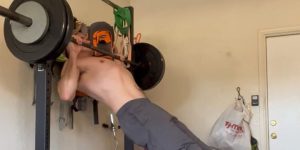The four-day upper/lower split is one of the most tried and true lifting splits of all time. Many classic barbell programs, like 5/3/1, Westside Conjugate, and Juggernaut are based around a simple split of two upper body-focused days per week and two lower body-focused days per week.
But what about the calisthenic enthusiast or the lifter who’s suddenly found themselves strapped for time? Is it possible to make this split work with basic calisthenic or bodyweight exercises at home?
Not only is it possible – it’s been done, successfully, by many individuals over the decades.
A bodyweight upper/lower split is very doable as long as the trainee follows the general best practices of strength and hypertrophy training. That is to say, the effort per set is sufficient to drive growth, and the weekly volume per body part is sufficient to drive progress over time.
What follows are the details of a specific upper/lower bodyweight program split using classic push-ups, pull-ups, squats, dips, etc, and some potential modifications to make it fit your schedule.
Calisthenics Upper/Lower Split Program
The program below is about as basic and balanced of a program as you’ll ever find, using basic calisthenics. If you’re familiar with 5/3/1 or any similar classic upper/lower plan, then this schedule will feel familiar to you. Each exercise has a particular point of focus.
For the upper body, we’ve got a heavy back day with some light pressing, and a heavy chest/triceps day with some light pulling. Both days utilize antagonistic supersets for maximum efficiency.
For lower body, we’ve got a compound leg day with an emphasis on quads, and a compound leg day with an emphasis on hamstrings.
Monday: Upper A (heavy pull, lighter press)
- Pull-up variation of choice: 6 sets to 2-3 RIR
- Push-up variation of choice: 6 sets to 2-3 RIR
- Super-set the exercises and rest 1 minute between exercises
- Vary grips on pull-ups as you go. For instance, you may do the first 3 sets with a normal overhand grip, and the last two sets with a supinated, underhand chin-up grip as you fatigue.
Tuesday: Lower A (quad-dominant lower body)
- Bulgarian Split Squats: AMRAP in 1 minute for 6 sets (weaker leg)
- Bulgarian Split Squats: AMRAP in 1 minute for 6 sets (stronger leg)
- Rest 1 minute between legs, for a total of 12 rounds.
- We’re purposely starting with the weaker leg, and then attempting to “match” the number of reps with the stronger leg on the next set.
Thursday: Lower B (heavy press, lighter pull)
- Dips: 6 sets to 2-3 RIR
- Inverted Rows: 6 sets to 2-3 RIR
- Super-set the exercises and rest 1 minute between exercises
Friday: Lower B (hamstring-dominant lower body)
- Reverse lunges: AMRAP in 1 minute for 6 sets (weaker leg)
- Reverse lunges: AMRAP in 1 minute for 6 sets (stronger leg)
- Rest 1 minute between legs, for a total of 12 rounds.
- As with Workout B above, we’re purposely starting with the weaker leg, then attempting to match the number of repetitions with the stronger leg.
In this program, you would take Wednesday, Saturday, and Sunday as rest days. However, you could just as easily move days around to suit your schedule (for instance, Westside Conjugate lifters are fond of Mon/Wed/Fri/Sat) splits.
If you desire to make the program more difficult and/or bias your adaptations towards strength, feel free to utilize a weighted vest throughout the program.
The important part is to space rest days in such a way that you’re able to recover from session to session, (which is fairly easy on training splits that separate muscle groups by workout day).

Why this program works
This program works well because, just like my bodyweight push/pull/legs program, it follows best practices for hypertrophy from resistance training.
By sticking with 6 sets per body part per workout, we’re able to achieve 12 sets per body part per week. This is well within the recommended 10-20 sets per body part per week recommendation for muscle growth.
As in any other bodyweight program, don’t focus so much on rep range as you do on effort per set. Since it’s hard to incrementally load bodyweight exercises (like you would with, say, bench presses), it’s much harder to dial in a 8-12 rep set the way you would in traditional strength training.
This program utilizes “reps in reserve” (RIR) style training for exactly this reason: by tracking how many reps we had left in the tank, we can reasonably assume that the set itself was “difficult” enough that it recruited all the motor units necessary for growth.
You are welcome to progressively add sets to move towards the higher end (18-20 sets) of the volume recommendation, but personally, I would rather add extra days rather than extra sets. The current evidence shows that the effectiveness of resistance training exercises drops off significantly after about six hard sets in a given session.
For this reason, if you’re looking to increase the volume from here, I would opt for a 6-day or 5-day variation of the program (details below).
Potential modifications to the basic bodyweight upper/lower split
If you don’t have a dip station
The only equipment you’ll need is a place to do pull-ups and a place to do dips. A power tower will suffice, or a doorway pull-up bar and stand-alone dip station. However, if you don’t have a dip station, feel free to sub out dips for a sufficiently “difficult” compound pressing exercise (such as a weighted push-up) on Thursday.
Options for this “heavy” press could include:
- Weighted decline push-ups
- Steep decline push-ups in general
- Pike or handstand push-ups
6-day calisthenics upper/lower split
If you desire to do this program over six days, rather than four, you can easily do so by splitting up the volume. Note that if you increase your training frequency in this manner, I do not recommend keeping the total volume per session the same – drop it to 4 sets per exercise. This volume-equated version of the program will keep the program’s overall recovery demands the same:
- Monday: Upper A, 4 sets
- Tuesday: Lower A: 4 sets
- Wednesday: Upper B, 4 sets
- Thursday: Lower B, 4 sets
- Friday: Upper A, 4 sets
- Saturday: Lower A, 4 sets
In this case, you would simply reverse the order of the sessions in the following week:
- Monday: Upper B, 4 sets
- Tuesday: Lower B: 4 sets
- Wednesday: Upper A, 4 sets
- Thursday: Lower A, 4 sets
- Friday: Upper B, 4 sets
- Saturday: Lower B, 4 sets
If your recovery ability allows it, feel free to move to 5 sets per exercise per session over a couple of weeks, and eventually to six sets per exercise per session. If would not go above six sets per exercise per session, as you’ll likely run into diminishing returns at that point.
5-day bodyweight upper/lower split
A favorite workout split of old-school bodybuilders such as Vince Gironda was to complete an upper body day three times per week, and a lower body day two times per week. This is generally because the muscles of the upper body are smaller and recover faster, whereas lower body muscles are larger and generally require more time to be ready to lift again. If you desire to utilize such a scheme, you could easily modify this program to fit a 5-day schedule:
- Monday: Upper A, 4 sets
- Tuesday: Lower A: 6 sets
- Wednesday: Upper B, 4 sets
- Thursday: Lower B, 6 sets
- Friday: Upper A, 4 sets
One thing to note: if you’ve got five or six days per week to lift, you may also want to take a look at something like a bodyweight push/pull/leg split or even the classic calisthenic bro split. This split is more directly set around a 6-day lifting schedule and requires no modification to be run in this fashion.
If fat loss is your goal
Though proper diet is the main key to making a fat loss program work, I’ve had great luck with myself and those I’ve coached by simply adding a one-mile run before and after my lifting sessions when I desire to lose weight along with the training plan.
One note if you try to do this: you may want to work up to it over a period of about four weeks:
- Week 1: run a quarter mile before and after each lifting session (2 miles total per week)
- Week 2: run a half mile before and after each lifting session (4 miles total per week)
- Week 3: run three-quarters of a mile before and after each lifting session (6 miles total per week)
- Week 4: run a full mile before and after each lifting session (8 miles total per week)
If strength is your goal
If your goal is to get as strong as possible utilizing these basic exercises, I would recommend getting your hands on a weighted vest and incrementally loading your resistance training with a weighted vest.
Though any type of weighted vest will do, I personally prefer the “ingot” style weighted vests for the ability to incrementally load the vests 2.5 lbs at a time.
Can I run a 2-day or 3-day upper/lower bodyweight split?
Though you could technically volume-equate the workload from the program above to shoehorn it into a 2-day or 3-day schedule, I would generally advise against it.
If you’re planning on workout out three days per week, then something like a full-body heavy, light, medium bodyweight program makes the most sense.
If you’ve only got two or three days per week to lift, then I would recommend simply abandoning the upper/lower split idea in favor of a full-body workout plan.
Get after it!
As mentioned above, upper/lower workout programs are classic for a reason – they work! By separating the upper and lower body into different days, we are allowed to focus more specifically on simply building muscle in the target muscle groups and then getting the hell out of the gym.
The only thing left to do is to get lifting. Good luck!













